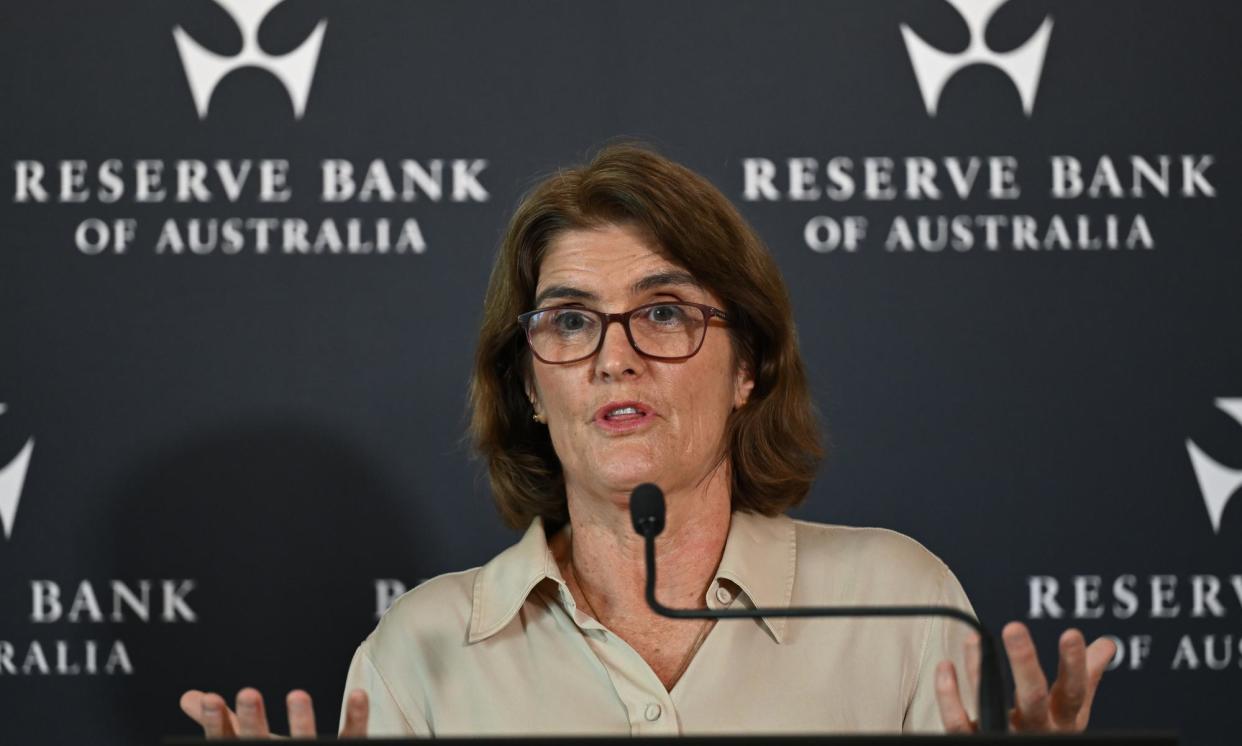RBA holds interest rate but Michele Bullock warns war on inflation ‘isn’t yet won’

Australian borrowers have been granted another reprieve by the Reserve Bank but should not expect an early rate cut because the war against inflation “isn’t yet won”, governor Michele Bullock said.
The RBA board left its cash rate unchanged at a 12-year high of 4.35% after its second two-day gathering of 2024 concluded on Tuesday afternoon. The result was widely expected by economists.
“We’re making progress in our fight against inflation but it does remain high,” Bullock told journalists at a post-decision media conference in Sydney.
“Recent data suggests we are on the right track but the interest rate path that best ensures we bring inflation down to target remains uncertain.”
The central bank has left itself the option of raising interest rates again if necessary as the risks to the outlook are “finely balanced”, Bullock said.
“While recent data indicate that inflation is easing, it remains high,” the RBA said in a statement. “The board expects that it will be some time yet before inflation is sustainably in the target range [of 2%-3%].”
“The path of interest rates that will best ensure that inflation returns to target in a reasonable timeframe remains uncertain and the board is not ruling anything in or out,” it said.
The treasurer, Jim Chalmers, told parliament the decision was “a reflection of the good progress we’re making as a country in the fight against inflation”.
“It gives us confidence that inflation is moderating in welcome and encouraging ways,” he said.
Australia’s interest rates started rising later than many similar economies as the central bank sought to stem inflation that peaked in the December quarter of 2022 at 7.8%. The RBA targets prices to rise between 2% and 3% a year.
The economy all but stalled at the end of 2023, with GDP expanding just 0.2% for the December quarter. Excluding population growth, economic activity per person contracted 1% from a year earlier, the worst result outside the Covid pandemic period since the 1990s.
Before today’s decision, economists such as Timo Henckel, the chair of the Australian National University’s shadow RBA board, said the central bank would likely hold rates steady until it was “really sure” inflation would fall to its target range by mid-2025.
Henckel noted inflation in the US had fallen “but that easing seems to have stalled a little bit”, a trend that would likely make the RBA cautious about acting too soon to cut interest rates here. “There’s a strong case and push to keep [rates] on hold.”
While some households were definitely enduring difficult conditions, “others were doing really well”, he said.
While the unemployment rate had lately climbed to 4.1%, the labour market was “still travelling by historical standards reasonably well”, Henckel said. February jobs figures are scheduled to be released on Thursday.
Market reaction saw the dollar ease slightly against the US dollar to 65.5 US cents, while stocks added to gains to be about 0.3% higher for the day.
Related: Interest rate rise unlikely after sluggish quarter of GDP growth, Australian economists say
Bullock said the board needed “greater confidence” that inflation remained firmly on course to reach the mid-point of 2.5% by 2026.
Her comments implied the RBA did not consider a rate cut at the meeting since demand in the economy continued to exceed supply. That said, the unemployment rate remained “firmly on the board’s radar”, she said.
“We think monetary policy is slightly restrictive,” she said, adding that it was too early to say when the RBA would end that tightening.
One reason why demand continued to exceed supply in the economy was the “elevated” level of population growth, she said.
As to setting interest rates at a level that did not allow unemployment to rise above a “sustainable” rate, “all we can do is to tread carefully”, Bullock said.
A financial stability review out on Friday will also look at market conditions, including “vulnerabilities” from rising asset prices in Australia and elsewhere.
The RBA noted the outlook remained “highly uncertain”, and the board remained “highly attentive to inflation risks”. China’s economy and conflicts in Ukraine and the Middle East were among the uncertainties.
“Employment is expected to continue to grow moderately and the unemployment rate and the broader underutilisation rate are expected to increase a bit further,” the statement said.
EY’s chief economist Cherelle Murphy said the RBA had “toned down its language ever so slightly”.
Murphy said the RBA would get first-quarter consumer price inflation on 24 April, in time for the board’s next meeting on 6-7 May. “A rate cut by the third quarter is far from a done deal in our view,” Murphy said.
The decision to hold rates steady may add to confidence for buyers in the property market, Tim Lawless, the research director at CoreLogic Asia Pacific, said prior to today’s decision.
“Following the 6.2% rise in the February consumer sentiment reading from Westpac and the Melbourne Institute, a further lift in confidence could be accompanied by a rise in home purchasing,” Lawless said. “This could add to housing demand that has already remained quite resilient despite the higher interest rate environment and cost-of-living pressures.”


